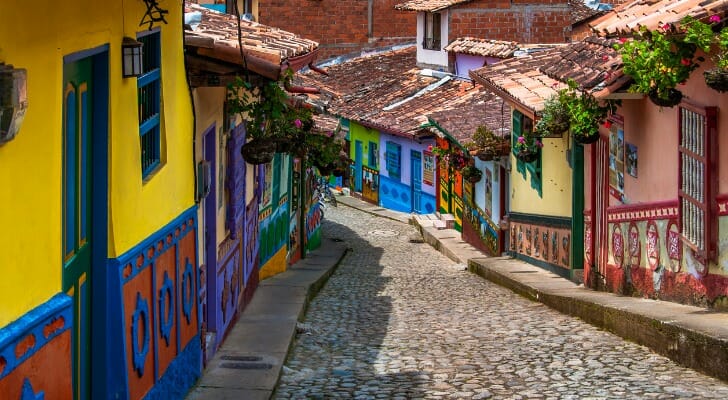Looking to retire in a country with stunning landscapes and welcoming locals? Colombia might be the perfect choice for you. Over the past decade, it has become an increasingly popular destination for American retirees. However, before making the move, it’s important to understand key details like the cost of living, immigration requirements, healthcare options and more.
A financial advisor can help you put a financial plan together for your retirement goals and needs.
Average Cost to Retire in Colombia
It’s often challenging for retirees to maintain their lifestyle while in retirement due to living on a fixed income. Fortunately, Colombia offers retirees an affordable yet comfortable way of life. According to Numbeo, a website that collects pricing data from citizens, you’ll need to budget (excluding rent, but including food, utilities, transportation and recreation) around $250 per month for living costs. In more expensive cities like Bogotá, Medellín and Barranquilla, you may expect to spend a bit more, and you can expect to spend a bit less in cities like Bucaramanga or Pasto.
Utility costs include garbage service, electricity and water, which average about $80 for Colombia, according to Numbeo. The national average costs for broadband internet with unlimited data is $30, which can help you connect with your loved ones.
Rent is about three-fourths lower in Colombia than in the United States. The national average for an urban one-bedroom apartment is about $345 per month and about $290 per month for a suburban apartment. If you want more space, the national average for a three-bedroom apartment is about $626 per month in a city center and roughly $501 per month in the suburbs.
However, rent prices will vary depending on what city you choose. For example, a one-bedroom apartment in the city center of Bogota averages about $420 per month.
Healthcare in Colombia
Healthcare is a key concern for many retirees looking to relocate abroad. Fortunately, Colombia offers quality healthcare options. Major cities in Colombia are home to reputable clinics and hospitals, many of which have bilingual doctors. For non-Colombians, there are two primary types of healthcare coverage available.
The first option is Entidades Promotoras de Salud (EPS), a public healthcare system that is mandatory for all residents. The second is Medicina Prepagada, a private health insurance plan offered by various providers. To apply for EPS, foreigners need a resident ID card, while a passport is sufficient to obtain a private Prepagada policy.
However, if you’re over 60 or have certain pre-existing conditions, you may be denied coverage under Medicina Prepagada. In that case, exploring a global health insurance policy could be a suitable alternative.
Visa Laws
The visa that most expatriates use is the pensionado visa (TP-7). The visa costs roughly $282 and has a few requirements that retirees must meet to receive it. To qualify, retirees must prove that they have an income of at least three times the minimum salary in Colombia. If you aren’t earning a full-time income in retirement, don’t worry. Your Social Security, pension and retirement savings account income that comes in each month counts as income.
There are also a few documents that you must show to receive a visa. These include:
- A valid passport with at least two open pages and an expiration date of at least 180 days in the future
- Copy of passport ID page
- Copy of passport page with your most recent trip to Colombia
- Proof of pension from either the U.S. government or a private company
- Additional passport photo
Individuals can apply for a retirement visa online or at a Colombian embassy or consulate in the United States. Once you have received your visa, you must apply for a foreigner ID called a Cedula Extranjeria within 15 days. The TP-7 visa is good for a year, and will need to be renewed each year. After five years, visa holders are eligible for a resident visa. The resident visa is good for five years.
Housing in Colombia

One of the biggest factors in moving to a new country is procuring housing. Fortunately, the home buying process is very similar to the United States, and is relatively simple: all you need is a valid passport and enough funds.
Obtaining a mortgage in Colombia can be quite challenging. The most secure approach is to plan on purchasing a home or apartment with cash. To qualify for a mortgage, you generally need to have several years of established credit in Colombia and hold permanent residency.
In terms of costs, homes in Colombia’s city centers average around $110 per square foot, while properties outside city centers are slightly lower at approximately $95 per square foot. In comparison, homes in the U.S. are significantly more expensive, averaging over $330 per square foot in city centers and nearly $200 per square foot in suburban areas.
Housing Process in Colombia
The process of buying a home in Colombia is the same for foreigners as it is for locals. Additionally, purchasing property can open the door to obtaining a residency permit, which is why many retirees choose to buy rather than rent.
As you start exploring different cities, neighborhoods or regions to settle in, it’s essential to work with a qualified realtor and lawyer. These professionals will guide you through the home-buying process and help ensure you avoid properties with legal disputes or other complications.
Once you’ve found a property you’re interested in, your lawyer can assist you in obtaining a Certificate of Tradition and Liberty. This document provides crucial details about the property, such as ownership history, existing debts, and other key information. The cost for the Certificado de Tradición y Libertad is approximately $5.
When purchasing a property, buyers are responsible for taxes and fees totaling about 1.65% of the property’s value. Sellers, on the other hand, are required to pay taxes and fees that amount to around 4% of the total property value.
Taxes for Retirees in Colombia
Expats who reside in Colombia for less than six months (183 days) will only be taxed on any income they earn directly from Colombia. They will pay a flat tax of 35%, no matter what their income level is. However, for those who reside in the country full time, they will be taxed according to their income level, ranging from 0% to 39%.
Keep in mind that even if you live outside the U.S., you’ll still need to file a U.S. tax return as an expat. You’ll also have to file even if you don’t end up having to pay any U.S. taxes. It’s unlikely you’ll have much income originating from outside the U.S. in retirement. If you do, however, you can use a few different provisions to reduce your U.S. taxable income.
These include the foreign earned income exclusion, the foreign tax credit and the foreign housing exclusion, among others. If you’d like to forecast your tax burden more specifically, you may want to consult a tax expert familiar with both U.S. and Colombian tax laws.
Bottom Line

Colombia has become a favored retirement destination for many Americans. Known for its safety, stability and welcoming locals, the country offers a lower cost of living and more affordable housing options compared to the United States. If you’re considering retirement in Colombia, it’s important to factor in the cost of living, visa and immigration regulations, as well as your ideal location within the country to determine if it’s the right fit for you.
Tips for Retirement
- Consider talking to a financial advisor about the pros and cons of retiring outside the United States. Finding the right financial advisor who fits your needs doesn’t have to be hard. SmartAsset’s free tool matches you with up to three financial advisors who serve your area, and you can interview your advisor matches at no cost to decide which one is right for you. If you’re ready to find an advisor who can help you achieve your financial goals, get started now.
- An essential part of saving for retirement is making sure the money you save remains untouched. Dipping into your savings may seem tempting if you’re low on cash, but you’ll pay for it down the line. Consider creating an emergency fund instead.
Photo credit: ©iStock.com/Jiann Ho, ©iStock.com/RicardoImagen, ©iStock.com/OSTILL
